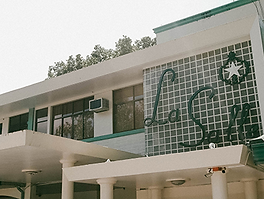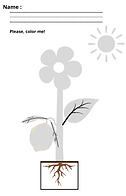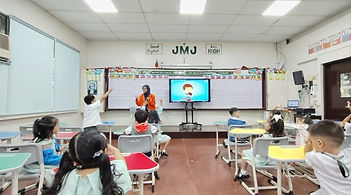University of St. La Salle's Profil
The University of St. La Salle (USLS) is a prestigious integrated school of Catholic private research institution managed by the De La Salle Brothers. The USLS Health Sciences Campus, located on La Salle Avenue in Bacolod, Negros Occidental, Philippines. In 1952, La Salle-Bacolod was established through the guidance and efforts of its three Founding Brothers: Bro. Felix Masson, Bro. Hugh Wester and Bro. Dennis Ruhland, the first Director of the school. It is recognized as the second-oldest De La Salle campus in the country and the first established outside Manila. USLS is a member of De La Salle Philippines, a network that has encompassed 16 Lasallian educational institutions since 2006. The university provides comprehensive educational programs from preschool to postgraduate level programs, with major fields of study including Business and Accountancy, Engineering and Technology, Arts and Sciences, Education, Nursing, Law, and Medicine. Major in Academic Program :
College Arts and Science :
Arts and Humanities, Biology, Communication Studies, Computer Science, Economics, Information Technology, Marketing, Mass Communication, Political Sciences, Psychology.
College Business and Accountancy :
Accountancy, Agricultural Business, Business and Commerce, Economics, Human Resources, Management, Marketing, Tourism.
College Education :
Art Education, Education, English, Foreign Languages Education, Health Education, Mathematics Education, Music Education, Physical Education, Physics, Primary Education, Secondary Education, Social Studies, Special Needs Education, Teacher Training.
College Law :
-
Law
College Nursing :
-
Nursing
College Medicine :
-
Medicine
Vission :
University of St. La Salle is a premier, responsive learning community, advancing human and Christian education, through research, innovation, and social engagement in Asia and the Pacific, in the service of humanity.
Mission :
True to our Catholic tradition and inspired by St. John Baptist de La Salle, University of St. La Salle forms persons of integrity and excellence, committed to the shared mission of caring for peoples and the Earth.
Motto :
Religion, Morals, Culture
Color :
Green and White
The University of St. La Salle offers a variety of facilities that support learning, including spacious grounds, cafeteria, bookstore, market, toilet, a swimming pool, tennis courts, basketball courts, a running track, a museum, faculty rooms, classrooms, gardens, parking areas, and library. In the Kinder and Pre-Kinder classrooms, facilities include tables, chairs, whiteboards, screens, printers, bag racks, bookshelvesand air conditioning
Academic Support System









Teaching System
This is Teacher Vevs, my cooperating teacher and advisory of kinder B class. She is a good teacher, kind, patient, and smart.
At the University of St. La Salle (USLS), there are two Kinder classes: Kinder A, with 15 students, and Kinder B, with 13 students. Meanwhile. Each class is led by one teacher and one assisted who called manang, she helps the teacher during the learning process. This is Teacher Angel, who teaches Pre-Kinder class with 8 students.
All classes at USLS for the first session in the morning is start from 08:00 am and and finish adjusting each class. But, the Pre-Kinder class is start from 12:00 pm until 02:00 pm. Learning for Kinder and Pre-Kinder classes is follow a teacher-centered approach, where the teacher serves as the main source of instruction. Lessons are delivered through direct instruction, utilizing screens or whiteboards to support explanations and enhance understanding.


Pedagogical Content
At the University of St. La Salle, classes begin at 8:00 AM with a prayer, followed by the singing of the national anthem. Even though some students may not have entered the classroom by exactly 8:00 AM, the anthem still plays and many children choose to stop in their tracks and sing along until the song finishes. Once the anthem is over, they continue walking into their classrooms.
In the Kinder classroom, after singing, the teacher leads the children in greeting the teachers and classmate present. This is followed by a sing and dance exercise to energize the students. The teacher then engages the children by asking about the day, date, and weather before proceeding to writing activities and other learning sessions. Philippines learning is developed to support K-12 Basic Education Curriculum and the principles of the National Early Learning Framework (NELF).
Learning for kinder B class are math, reading/literacy, makabansa, language, CLE, GMRC (Good Manners and Right Conduct). During the lesson, the teacher introduces the topic of the day by playing a video, helping children visually understand the material. Afterward, they work on prepared worksheets or other assignments related to the lesson. Once the learning session ends, the children wash their hands and have a short snack break before continuing their lessons until 11:00 AM.
At 12:00 PM, the Pre-Kinder session begins and runs until 2:00 PM. The structure follows the same sequence as the Kinder class starting with a prayer, singing the national anthem, greeting teachers, a sing-and-dance exercise, and discussing the day, date, and weather. The learning activities follow the same method, incorporating videos for visual learning and worksheet exercises.
After completing the lessons, the children wash their hands and have a snack while watching cartoons as they wait for their parents to pick them uper singing, the teacher leads the children in greeting the teachers and classm present. This is followed by a sing and dance exercise to energize the students. The teacher then engages the children by asking about the day, date, and weather before proceeding to writing activities and other learning sessions.
Materials and Innovation


The teacher reviews and adapts the existing curriculum for the learning process. They design lessons by creating lesson plans, which include instructional materials, learning media, and assignments. The lesson content is determined based on the scheduled day and designated topic. For example, on February 14, which is known as Valentine’s Day, the teacher engages children in making something special to give to their parents and give it when picking up from school as part of the celebration. For learning materials, the teacher primarily uses video resources from YouTube, while the necessary tools and materials are also provided by the teacher according to the lesson topic.
Sources of Learning and Techonology

Every teacher during learning session are carried out with various materials depending on the learning and technology that uses a laptop for connected to a television to provide materials visually.
Autentic Assessment
During the learning process, the teacher provides guidance and direction to the children, as well as corrects any mistakes they make. Additionally, the teacher assesses the children’s work when assigning tasks such writing and other tasks as in the following picture. Then Teacher will give a direct assessment to the student’s book or paper.
Teaching Plan
My friends and I had initially planned to teach Filipino children about Indonesian culture. However, when I arrived in the Philippines, my cooperating teacher offered me the opportunity to teach a practical life lesson on the topic of plants. But it’s okay, I also enjoyed the lesson topic that was given to me.So, before I conducted my teaching demonstration, I created a simple lesson plan, similar to the ones used in Indonesia. This lesson plan served as a guideline for teaching in both Kinder B and Pre-Kinder classes, allowing me to adjust to class conditions, learning concepts, materials, and resources.
Lesson plan



worksheet
Observation On Teacher(s)
For my observation on teachers, I closely observed how Teacher Vevs and Teacher Angel conducted their lessons, managed the classroom, and interacted with the students. Before teaching, the teacher organized the classroom, prepared new materials and content that continued from previous lessons, and ensured that all necessary equipment was set up. This included connecting the laptop to the internet and linking it to the television for visual displays. Then, the teacher warmly welcomed the students as they arrived, creating a positive and engaging learning atmosphere from the start. During the observation, I also paid attention to how they handled classroom discipline. One of the similarities with kindergarten practices in Indonesia is how children are lined up in a long queue, one by one, before washing their hands or leaving the classroom. This routine helps maintain order and teaches children discipline while transitioning between activities. They maintained a warm and patient attitude, but they set clear boundaries to ensure the students stayed focused. I observed was their use of positive reinforcement, such as praising students for their efforts and encouraging participation through interactive questioning.
Additionally, I noticed how they adapted their teaching methods based on the students' needs. In Kinder B, the lessons were more structured and included a variety of materials, such as worksheets and visual aids, to support learning. Meanwhile, in Pre-Kinder, lessons were shorter and involved more hands-on activities to match the children's attention span. These observations helped me understand the importance of flexibility in teaching approaches and the need to tailor lessons to suit different age groups.
Teaching Practice
At the beginning of my teaching experience abroad, I was given the opportunity to manage a class independently, where I became the center of learning for the children. This experience taught me many valuable lessons, especially in interacting with children, delivering lessons in English, and managing the classroom to keep it both active and conducive to learning. My teaching practicum lasted for only one day, focusing on the topic of plants in two different classes.
First Session: Kinder B Class
For the first session, I taught the Kinder B class at 9:00 AM. Before that, at 8:00 AM, the class was still handled by Teacher Vevs. I started by preparing the materials I would display on the television, such as pictures, YouTube videos, and worksheets for the children.
I began the class by greeting the children and leading them in prayer. Before introducing the lesson, I engaged the children by showing them a picture and encouraging them to guess the topic of the day. Once they figured out that we would be learning about plants, I played a YouTube video, pausing it at certain points to provide explanations.
After watching the video, the children worked on their worksheets. I concluded the lesson by inviting them to share their thoughts and stories about plants. I was surprised by how enthusiastic the Kinder B students were—many of them wanted to share their stories, some even coming forward twice! This made it a bit challenging to end the session on time, as I was only supposed to teach for one hour. Fortunately, Teacher Vevs helped me wrap up the session, and we ended with a group photo.
After the lesson, Teacher Vevs gave me feedback. She mentioned that my performance was nearly perfect but suggested that I should have provided a more concrete example of plants instead of relying solely on the video. To improve my teaching demonstration in the second session, she recommended bringing a real plant to show the children its structure directly.
Second Session: Pre-Kinder Class
For the second session, I taught the Pre-Kinder class at 12:00 PM with the same topic on plants. I started the class by leading the children in prayer and singing the national anthem, with the help of Teacher Angel, as I wanted to respect their religious practices.
Before starting the lesson, Teacher Angel introduced me to the eight children in the class, as I had never observed this class before. I found it a bit challenging to build rapport with the Pre-Kinder students because they were unfamiliar with me. However, I continued the lesson by introducing myself to them.
To capture their attention, I again used pictures to spark curiosity about the topic. Then, I played a video and explained the structure of plants while showing them a real plant. After my explanation, I invited the children to take turns pointing out the parts of the plant themselves. Afterward, the children worked on their worksheets until everyone had finished. I wrapped up the session with a group photo.
After finishing the lesson, Teacher Vevs gave me feedback again and asked which class I found more challenging: Kinder B or Pre-Kinder. I answered that the Pre-Kinder class because their participation was not as active as the Kinder B students. Teacher Vevs agreed with my observation. I was also curious why the Pre-Kinder students seemed quieter with me but were more vocal with Teacher Angel.
I assumed that since I had never entered their class before, the children were not yet comfortable with me, which made interaction more limited at first. Because of this curiosity, I decided to observe and join more sessions in the Pre-Kinder class. After a few visits, I realized that they were not as quiet as they initially seemed—they could actually interact with me a lot more.





Summary and Suggestions
Purpose of Practicum
The main purpose of my practicum was to gain hands-on teaching experience in an international setting, where I could apply my teaching skills, interact with children using English, and learn effective classroom management strategies. This experience also allowed me to understand different teaching methods and how they can be adapted to suit different learning environments.
Procedures of Practicum
My practicum lasted for one day, during which I taught two different classes—Kinder B and Pre-Kinder.
-
First Session – Kinder B (9:00 - 10:00 AM)
-
Prepared lesson materials, including pictures, a YouTube video, and worksheets.
-
Started the class with greetings and a prayer.
-
Engaged students by showing a picture and letting them guess the topic.
-
Played a YouTube video while pausing at intervals to explain key points.
-
Guided students in completing their worksheets.
-
Concluded the lesson with a storytelling session and a group photo.
-
-
Second Session – Pre-Kinder (12:00 - 01:00 PM)
-
Prepared lesson materials, including pictures, a YouTube video, and worksheets.
-
Started the class with greetings, prayer and the national anthem with Teacher Angel.
-
Teacher Angel introduced me to the students.
-
Captured the children’s attention using images and guessing activities.
-
Played a video and explained the structure of plants while showing a real plant.
-
Encouraged students to identify plant parts.
-
Assisted students in completing worksheets.
-
Ended the session with a group photo.
-
Outcomes of Practicum
-
Kinder B students were highly engaged and actively participated in storytelling, making it a lively session.
-
Pre-Kinder students were initially reserved, but after several interactions, they became more responsive and interactive.
-
Received constructive feedback from Teacher Vevs, who suggested incorporating real-life objects (plants) to make the lesson more concrete.
The Challenges of Practicum
Since I had not previously observed the Pre-Kinder class, it was initially challenging to connect with the children. They were quieter and less responsive compared to the Kinder B students. However, after several interactions, they gradually became more engaged and comfortable with me. On the other hand, the Kinder B students were very enthusiastic and eager to participate, which sometimes made it challenging to manage both the class and time effectively
Overall Impression
This practicum has been an eye-opening experience that has allowed me to grow both personally and professionally. Throughout this journey, I have gained valuable insights into different teaching methods and classroom management strategies in an international setting. The support from the teachers and the enthusiasm of the children made my experience even more fulfilling. Despite the challenges, every moment spent with the students was rewarding and taught me the importance of patience and adaptability in teaching. Even though I am still far from perfect in teaching them, I was happy to see that they warmly accepted me. The children were incredibly sweet and adorable, making my teaching experience even more enjoyable. I am especially grateful to the Kinder B students, as I spent the most time in their class, while I only had a few sessions in Kinder A. This experience has truly strengthened my passion for early childhood education, and I am deeply grateful for the opportunity. Thank you so much to Teacher Vevs, Teacher Angel, and all the wonderful children from Pre-Kinder, Kinder A, and Kinder B.
Sugesstions for Future Improvement
Establishing a connection with students before teaching allows them to feel more comfortable and engaged during the lesson. Simple interactions, such as greeting them warmly, engaging in small conversations, or participating in their daily routines, can help build familiarity and trust, making it easier to capture their attention when the lesson begins.
Utilizing real-life objects and hands-on materials enhances students’ understanding by allowing them to experience concepts in a tangible way. For example, instead of only showing pictures or videos of plants, bringing an actual plant into the classroom enables students to observe its structure firsthand, touch the leaves, and explore different parts, making the learning process more interactive and meaningful.

